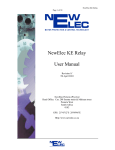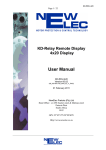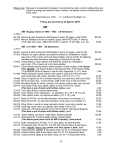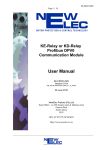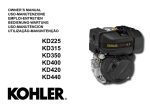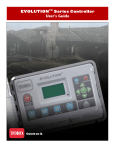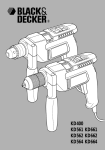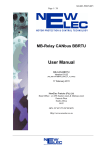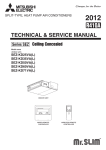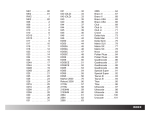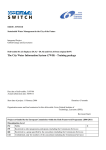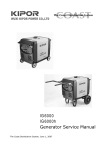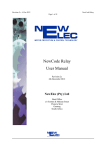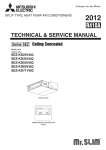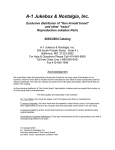Download KD Relay User Manual (kd_relay_user_manual_01h)
Transcript
NewElec KD-Relay
Page 1 of 27
NewElec KD Relay
User Manual
Revision 1h
29th January 2010
NewElec Pretoria (Pty) Ltd
Head Office: Cnr. 298 Soutter street & Maltzan street
Pretoria West
South-Africa
0182
GPS: 25°45'12''S 28°09'46''E
http://www.newelec.co.za
NewElec KD-Relay
Page 2 of 27
CONTENT
Page
1.
ABSTRACT
3
2.
SPECIFICATIONS
4
3.
DEFINITIONS AND TERMINOLOGY
10
4.
FUNCTIONAL DESCRIPTION
12
5.
5.1
5.2
INSTALLATION INSTRUCTIONS
Front-end requirements
Setup procedure of relay
14
6.
6.1
6.2
6.3
6.4
6.5
6.6
6.7
6.8
6.9
6.10
6.11
6.12
DIAGRAMS:
Physical layout of the KD-relay
Block diagram of the KD-relay
System diagram / Wiring diagram
Front-end settings screen
Front-end control logic screen
Front-end test screen (Manaual & Automatic Control)
Relay trip times (KD and KE trip curves)
Relay setting ranges and default settings
Mechanical Drawing of the KD-Relay
FLED (Field Light Emitting Diode Display)
RDU (Remote Display Unit)
KD-MMI-420-EP (Man Machine Interface)
7.
7.1
7.2
7.3
7.4
ACCESSORIES
FLED
IrDA interface
MMI
RDU
15
16
17
18
19
20
22
23
24
25
25
26
27
NewElec KD-Relay
Page 3 of 27
1.
Abstract
The KD-Relay is a ISO9001:2000 compliant locally designed and manufactured three
phase motor protection relay. It is a micro-controller based precision instrument with
protection and control logic. The relay’s design caters for the low voltage motor
protection market and is available in different current models. The current transformers
are internal and integrated into the relay while the core balance current transformer is
external. External current transformers are used to extend the range from 100 to 400A.
The relay is fully configurable with the aid of front-end software or a man machine
interface unit (MMI). Event records can also be down loaded with the MMI onto a
memory stick for further analysis. All the settings are password protected. The relay has
an on board database where time and date stamped records are kept. Two types of
records are kept namely fault records (60 last faults) and event records (2000 events). In
the case of event records, the user has limited access rights (read only). The front-end
also has a data recorder which could be used to analyze motor performance.
The relay detects earth leakage currents with the aid of the external core balance current
transformer and the relay is configurable to operate in inverse definite minimum time
(IDMT) or instantaneous definite time (IDT).
A unique feature is added to the relay in the form of simulation. This function could be
used for personnel training or relay functionality testing.
NewElec KD-Relay
Page 4 of 27
2.
Specifications
2.1
Measurements
2.1.1
Current
• Three phase current
• Models: KD5, KD10, KD25, KD50, KD100, KD200 and KD400
• Range: KD5 is 0,5 to 5 Amp, KD10 is 1 to 10Amp, ...... , KD400 is 40 to
400 Amps.
• Dynamic range: 0% to 1000%
• Expanded models: KD100 (100Amp), KD200 (200Amp) and
KD400(400Amp) will make use of 100:5, 200:5 and 400:5 CTs
respectively.
2.1.2
Voltage
• Range: 110V, 400V, 525V and 1050V (1050V requires an additional
attenuator circuit)
• Range selection: Manual or Automatic selection at power up. (1050V is
only manual selectable)
2.1.3
Frequency
• Range: 30Hz to 100Hz
2.1.4
Power Factor
• Range: 0 to 100% (leading / lagging)
2.1.5
Earth Leakage
• Range: 30mA to 3 Amps
• Trip time delay: Inverse Definite Minimum Time (IDMT) / Instantaneous
Definite Time (IDT)
2.1.6
Real Time Clock
• 24 hour clock (Year, month, date, hours and minutes)
• Battery backup (5 days with a 1 Farad super capacitor)
• Time and date stamping (Fault and event records)
2.1.7
Breaker Fault Clearance Time
• Measurement range: 10 ms to 1000ms
• Resolution: 10ms steps.
2.1.8
Insulation Resistance
• Measurement range: 1 to 199 kOhm
• Resolution: 1 kOhm steps.
NewElec KD-Relay
Page 5 of 27
2.2
Protection Features
(All resets are subjected to sufficient thermal capacity gain)
2.2.1
Over Current (Overload) Detection
• Curve class settings: 3 seconds to 40 seconds
• IEC 60255-8 specification
• Motor full load setting (MLC): 10% to 100% (on front panel)
• Reset: Manual or three automatic resets per hour (when selected)
• Reset threshold setting: Fixed at 70% thermal capacity or dynamic
threshold adjustment determined over 10 last restarts.
2.2.2
Undercurrent (Minimum load) Detection
• Trip level adjustment: 10% to 100% (on front panel)
• Selection: Current level or power factor
• Trip delay time: 1 to 10 seconds
• Startup delay: 1 to 200 seconds (To facilitate pump priming)
• Reset time: Manual or 10 seconds to 6 hours (9 steps)
• Feature selectable
2.2.3
Unbalance Phase Currents Detection
• Trip level adjustment: 0 to 50%
• Trip delay time: 1 to 10 seconds
• Feature selectable
• Reset: Manual
2.2.4
Single Phasing (Phase lost) Detection
• Trip delay time: 1 second fixed
• Feature selectable
• Reset: Manual
2.2.5
Run-Stall Detection
• Stall current trip level adjustment: 110% to 300%
• Stall trip delay time: 0 to 120 seconds adjustable
• Feature selectable
• Reset: Manual
2.2.6
Vectorial-Stall Detection
• Trip: Static or decreasing power factor
• Trip delay: 33% of curve class setting.
• Feature selectable
• Reset: Manual
NewElec KD-Relay
Page 6 of 27
2.2.7
Starts per Hour Control
• Starts setting: 1 to 30 starts adjustable
• Consecutive starts: 1 to 3 starts per interval adjustable
• Feature selectable
• Reset: Automatic
2.2.8
Short Circuit Detection
• Articulated detection: If (ILOAD > 950% and Power factor < 85%) or
(ILOAD > 300% and Power factor > 85%)
• Trip delay time: 1 second fixed
• Reset: Manual
2.2.9
Voltage Symmetry Detection
• Trip delay time: 10 seconds fixed
• Trip level adjustment: 70% to 100%
• Feature selectable
• Reset: Manual
2.2.10
Over Voltage Detection
• Trip delay time: 10 seconds fixed
• Trip level: Factory settings
• Feature selectable
• Reset: Manual
2.2.11 Under Voltage Detection
• Trip delay time: 10 seconds fixed
• Trip level: Factory settings
• Feature selectable
• Reset: Manual
2.2.12
High or Low Frequency Detection
• Trip delay time: 10 seconds fixed
• Trip level: Factory settings (45Hz to 55Hz)
• Feature selectable
• Reset: Manual
2.2.13
Voltage Phase Rotation
• No trip delay time
• Auto reset once fault is fixed
• Feature selectable (forward, reverse, none)
2.2.14
Insulation Failure Detection
• Detection: Only in static state (motor not running)
• Trip delay time: 1 second fixed
NewElec KD-Relay
Page 7 of 27
•
•
•
Trip level: Resistance < 20 kOhm (fixed)
Feature selectable
Reset: Manual
2.2.15
Earth Leakage Detection ( IEL < 2A)
• Selection between Instantaneous Definite Time or Inverse Definite
Minimum Time.
• Instantaneous Definite Time (100 ms ≥ t ≥ 1000 ms), (50 ms steps)
• Inverse Define Minimum Time ( t ≥ 130 ms)
• Harmonic filtering (suitable for variable speed drives and soft starters)
• Trip level: Adjustable
• Feature selectable
• Reset: Manual
2.2.16
Earth Fault Detection ( IEL ≥2A)
• Harmonic filtering (suitable for variable speed drives and soft starters)
• Trip delay time: 1 second fixed
• Trip level: 2A fixed
• Feature selectable
• Reset: Manual
2.3
Control logic
•
Configurable inputs can be connected with signal listed in the table below:
Zero ('0')
One ('1')
InService
VoltPresentF
OverCrnt_af
ShortCirc_af
RunStall_af
I_Unbal_af
SinglePhase_af
EarthFault_af
EarthLeak_af
MinLoad_af
OverVolt_af
UnderVolt_af
VoltSym_af
HiFreq_af
LoFreq_af
IsoLockOut_af
OverCrnt_tf
ShortCirc_tf
RunStall_tf
I_Unbal_tf
SinglePhase_tf
EarthFault_tf
EarthLeak_tf
MinLoad_tf
OverVolt_tf
UnderVolt_tf
VoltSym_tf
HiFreq_tf
LoFreq_tf
IsoLockOut_tf
PhaseRot_tf
StartsPerHr_tf
Timer_A
! Timer_A
Timer_B
! Timer_B
RTClock
! RTClock
LogicFunc_1
! LogicFunc_1
LogicFunc_2
! LogicFunc_2
2.3.1
Timers
• Timer A and Timer B
• Time setting: 0 to 50 minutes
• Start input: Configurable
• Reset / Inhibit input: Configurable
2.3.2
Real Time Clock (24 Hour)
• Start time: Hours and minutes configurable
LogicFunc_3
! LogicFunc_3
Restart
FrozenContact
TCap > THold
NewElec KD-Relay
Page 8 of 27
•
Stop time: Hours and minutes configurable
2.3.2
Logic function blocks
• Logic function 1, Logic function 2 and Logic function 3
• Three fully configurable inputs per logic function block
• Sum of product or product of sums operation
2.3.3
Relay 2
• Input: Configurable
• Single set of potential free switch-over contacts
2.4
Statistical Data Capturing
2.4.1
Running hours: Adjustable (0 to 65535 hours)
2.4.2
Startup counter: Adjustable (0 to 65535)
2.4.3
Trip counter: Adjustable (0 to 65535)
2.5
Trip Fault Recording
2.5.1
Database capacity: 60 last faults
2.5.2
Trip fault record content:
• Status: (Actual / simulated)
• Date: Year, month, date
• Time: Hour, minute
• Fault description
• Run hours
• Max trip current
• Minimum trip voltage
• Breaker fault clearance time.
2.6
Event Recording
2.6.1
Database capacity: 2000 last events
2.6.2
Event record content:
• Status: Actual, Simulated, Settings adjust, Power up, Calibration
• Date: Year, month, date
• Alarm flags
NewElec KD-Relay
Page 9 of 27
•
•
•
•
•
Trip flags
Run hours
Max trip current
Min trip voltage
Breaker fault clearance time
2.6.3
Down load control
Last events: 1 to 2000 selectable for down load.
Front-end will creates a spread sheet type of file (Can be viewed by MS
Excel(TM) or equivalent program)
2.7
Physical dimensions
2.7.1
2.7.2
Size of foot print: 100mm x 60mm (DIN Rail mount / screw fix mount)
Length: 150mm
2.7.3
Mass: 425gram
2.8
Auxiliary power supply
2.8.1
Voltage requirements: 110 Vac ± 10% or 230 Vac ± 10%
2.8.2
Power requirements: 2,2 Watt
2.9
Operating environment
2.9.1
Temperature: 0 – 50° Celsius
2.9.2
Relative humidity: < 85%
NewElec KD-Relay
Page 10 of 27
3.
Definitions and Terminology
Breaker clearance
time
It is the time taken by the breaker to clear the fault by interrupting
the supply current to the motor. It can be seen as breaker response
time and is useful information for breaker maintenance.
Consecutive starts The amount of starts allowed during a time interval created by the
starts per hour setting. (See also starts per hour)
Core balance
A current transformer used to detected possible current leakage to
current transformer earth from one or more of the phases. (Earth leakage detection)
Earth fault
It is leakage current above 2 amps and a severe form of an earth
leakage condition. (See also core balance current transformer)
Earth leakage fault It is leakage current up to 2 amps exceeding a trip level setting.
(See also core balance current transformer)
Full load current
Current drawn by the motor at full load operation (90% to 100%)
In Service
Phase current above 10% of full load current
Isolation lockout / The insulation resistance of the motor is measured while in a static
Insulation failure
(not in service) condition. If the resistance drops below 20 kOhm
the relay will trip and will prevent a start.
Motor full load
Adjustment of the relay current sensitivity. This is where the
setting (MLC)
current level measurement is adjusted to read just below 100%
when the motor operates at full load.
Non volatile
It is memory that will maintain data even when power is switched
memory
off for long periods. (see also volatile memory)
Over current
Current level above 100% of full load current
(Overload)
Phase rotation
Normal phase rotation is Red, white and blue. Reverse rotation is
blue, white and red.
Power factor
It is die relationship between real power and apparent power
Power factor % = ((V x I x Cos Ø) / (V x I)) x 100%
Power factor = Cos Ø
Run-Stall
The motor went through the normal start procedure and the current
level return to normal full level. If the rotor jam and the current rise
above the stall setting (110% to 300%) it is recognized as a RunStall fault condition.
Starts per hour
Starts per hour define the time interval in which a restricted amount
of starts are allowed. (See also consecutive starts)
Thermal capacity
It is a temperature related quantity expressed in percentage, which
also takes in consideration the physical size, mass, construction,
type of material used etc. of the motor. It is normally indicated as
capacity used unless otherwise stated.
Thermal curve
It is the particular curve that go through the maximum lock rotor
class
current point and the maximum time point where the motor can
survive in lock rotor condition. It is derived from the unit curve (1
second) with multiplication to create the appropriate curve for
continue ...
proper protection. (See diagram 6.7)
NewElec KD-Relay
Page 11 of 27
Undercurrent
(Minimum load)
Vectorial-Stall
Vectorial-Stall
continue ….
Volatile memory
Current level when motor run at no load condition or below
acceptable threshold.
It is detected during the start-up procedure of the motor. A motor
normally start-up with a bad power factor and gradually improve it
as full speed is approached. If no power factor improvement is
detected for longer then 33% of the curve class time the motor is
tripped to prevent thermal and mechanical damage.
It is memory that will loose data during a power supply interruption. (see also non volatile memory)
NewElec KD-Relay
Page 12 of 27
4.
Functional Description
The KD-relay is controlled by a micro-controller. The three phase currents,
voltages and earth leakage current are detected by current transformers, attenuator
circuits and a core balance current transformer respectively. The current and
voltage signals are conditioned by appropriate circuits and converted to 0 to 5 volt
analogue signals. The analogue signals are digitized to 10 bit resolution.
The micro-controller has non volatile and volatile memory. The non volatile
memory contains a boot loader program which is used to upload the operating
software program of the relay. The uploading is done from a personal computer
or laptop via the RS232 port. This feature also enables the user to do future
software upgrades without factory assistance.
Front-end software is included that runs on MS Windows™. The RS232 port is
used as the communication port. The purpose of the front-end is to configure and
select the required functionally of a specific application. The setup adjustments
required at the installation phase will be discussed in the next chapter dealing with
installation instructions.
The relay will monitor the parameters of the motor for the duration of auxiliary
power supply. The auxiliary power supply is selectable (110Vac or 230Vac).
When a trip condition occurs, the main trip relay will be activated. It will be
energized or de-energized (non fail save or fail save respectively) depending on
what mode of operation was selected. A time and date stamped trip record is also
generated and saved in non volatile memory for later retrieval. Memory space for
60 trip records is allocated. The layout of the trip record is discussed in chapter 2
that deals with specifications.
Event records are also time and date stamped. It is more comprehensive and
saved in non volatile memory. Only read access is given to the user. This
information can be used for insurance claims and liability cases. The layout of
the event record is discussed in chapter 2 (specifications).
Six fault indication light emitting diodes (red) are placed on the front panel. The
green light emitting diode will come on only if the relay is in a healthy state. A
healthy state signifies that the motor could be static or in operation within it’s
save operating parameters. The fault indications are displayed on the front panel
as follows:
Name of Fault
Over current
Short circuit
Minimum load
Phase Rotation
Indication LED used
Overload
Overload
Min Load
Phase Rotation
Display mode
Solid on
Solid on
Solid on
Solid on
NewElec KD-Relay
Page 13 of 27
Unbalance Phase Currents
Single Phasing
Insulation Failure
Run-Stall
Vectorial-Stall
Earth leakage
Earth fault
Over voltage
Under voltage
Voltage symmetry
Starts per hour
High frequency
Low frequency
Unbalance
Unbalance
Insulation failure
Overload
Overload
Earth leakage
Earth leakage
Phase rotation
Phase rotation
Phase rotation
Overload & Healthy
Unbalance
Unbalance
Solid on
Solid on
Solid on
Solid on
Solid on
Solid on
Solid on
3 sec on, 1 sec off
1 sec on, 3 sec off
1 sec on, 1 sec off
Both 1 sec on, 1 sec off
3 sec on, 1 sec off
1 sec on, 3 sec off
The reset button is used to acknowledge and reset trip faults. A reset will only
take affect if sufficient thermal capacity is regained during the cooling period and
no phase current flows. If the reset button is pressed during the cooling cycle the
Overload LED will start flashing (1 second on, 1 second off) to signify cooling.
Once the required thermal capacity level is reached, the relay will reset.
The real time clock is running from a battery or super capacitor which is continuously charged by the auxiliary power supply. The real time clock should be
able to run for another 5 days if the auxiliary supply went down. The real time
clock provides time and date for record keeping and also participates in the
control functions.
The main trip relay has a dedicated function and is exclusively used for protection. Relay 2 is configurable and is available to participate in the control functions.
NewElec KD-Relay
Page 14 of 27
5.
Installation Instructions
5.1
Front-end requirements
A Pentium personal computer or laptop is required to setup the KD-relay. The
computer must be equipped with a RS232 port. If only USB ports are available
an USB to RS232 converter may be used. The operating system software
requirement is MS Windows 2000, MS Windows XP or later versions. The frontend software is free but remains the property of NewElec (Pty) Ltd. It is supplied
with the purchase of new relays.
5.2
Setup procedure of the relay
Once the wiring has been done and checked by qualified personnel, the relay is
ready to be configured. The two most important front-end screens is the settings
(diagram 6.4) and control logic screen (diagram 6.5). These two screens enable
the user to set parameters, select protection functions and determine control
strategy. These two screens are also linked and when settings are saved to disk or
retrieved from disk.
When setting changes are made it has to be transmitted to the relay to become
effective. Changes on the control logic screen can only be made when off line is
selected. When on line is selected again, the settings are transmitted to the relay.
Relays are shipped to the user with a set of default settings and may be
appropriate in some cases.
To determine the full load current setting the motor has to be started and allowed
to run at full load capacity. Press the reset button (diagram 6.1 – 4) and turn the
max load dial (diagram 6.1 – 8) till the overload indication (diagram 6.1 – 11) just
switches off. Release now the reset button. The front-end can be used to confirm
that the load current level indicated is between 90% and 99%. The minimum load
setting adjustment (motor run with no load) is done in a similar way with the aid
if the reset button (diagram 6.1 – 4), minimum load setting dial (diagram 6.1 – 9)
and the minimum load indication (diagram 6.1 – 11).
The real time clock should be checked and adjusted to the correct time setting.
The fault history can also be erased to start afresh.
NewElec KD-Relay
Page 15 of 27
6.
Diagrams
6.1
Physical layout of the KD-Relay
7
1
2
8
9
10
3
11
4
5
12
6
13
1
2
3
4
5
6
7
Three phase voltage connector
Internal integrated current transformers
Serial Data Port (RS232 / I2C)
Reset switch
Minimum load reset time selector
Auto / manual switch (Thermal reset)
Auxiliary power supply (110V / 230V)
8
9
10
11
12
13
Motor full load setting dial (MLC)
Minimum load setting dial
Healthy indication
Fault indication light emitting diodes
Three phase power supply
Core balance current transformer
NewElec KD-Relay
Page 16 of 27
6.2
Block diagram of the KD-Relay
NewElec KD-Relay
Page 17 of 27
6.3
Wiring diagram of the KD-Relay
NewElec KD-Relay
Page 18 of 27
6.4
Front-end settings screen
NewElec KD-Relay
Page 19 of 27
6.5
Front-end control screen
NewElec KD-Relay
Page 20 of 27
6.6
Front-end test screen (Manual Control)
NewElec KD-Relay
Page 21 of 27
Front-end test screen (Automatic Control)
NewElec KD-Relay
Page 22 of 27
6.7 Relay trip times
KD Relay Thermal Curves
10000
Trip delay time (seconds)
1000
Clas s 1
Clas s 5
Clas s 10
Clas s 15
100
Clas s 20
Clas s 25
Clas s 30
Clas s 35
Clas s 40
10
1
0
2
4
6
8
Multipiles of Full Load Current
10
12
NewElec KD-Relay
Page 23 of 27
6.8
Relay setting ranges and default settings
Settings
Range
Parameter
Unbalance Current Trip Level
Unbalance Current Trip Delay
Run-Stall Trip Level
Run-Stall Trip Level Trip Hold Off Delay
Voltage Symmetry Trip Level
Line Voltage Selector
Earth Leakage Curve Selection
Earth Leakage Trip Level
Earth Leakage Trip Delay
Thermal Curve Class Selector
Thermal Capacity Reset threshold
Minimum Load Trip Level
Minimum Load Start Up Trip Delay
Minimum Load Run Time Trip Delay
Starts per hour allowed
Number of consecutive starts allowed
5 to 50%
1 to 10 seconds
110 to 300% I fl
1 to 10 seconds
85 to 100%
110; 380; 525 or 1000 V a.c
DMT OR IDMT
30 to 1000 mA
100 ms to 1 second
5 to 40 seconds
10 to 50 %
10 to 100%
1 to 200 seconds
1 to 10 seconds
1 to 30
1 to 3
Feature Selection
Overvoltage Disable
Undervoltage Disable
Voltage Symmetry Disable
Voltage Phase Rotation Disable
Reverse Voltage Phase Rotation BWR
Current Unbalance Disable
Short Circuit Disable
Single Phasing Disable
Run Stall Disable
Vectorial Stall Disable
Frequency Monitor Disable
Fail Safe Disable
Low Pass filter Disable
Dynamic T Cap Reset / Th adjust disabled
Starts per hour disabled
Earth Leakage Dissable
Isolation Lockout Disable
Minimum Load Disable
Under Current Selector
Power Factor Selector
Factory Preset
No
No
No
No
No
No
Yes
No
No
No
Yes
No
No
Yes
Yes
No
Yes
No
Yes
No
Factory
Default
15%
10 seconds
300%
0 Sec
85%
Auto
DMT
250 mA
150 ms
15 seconds
70%
33%
1 second
10 seconds
6
3
NewElec KD-Relay
Page 24 of 27
6.9
Mechanical drawing of the KD Relay
NewElec KD-Relay
Page 25 of 27
6.10 FLED (Field Light Emitting Diode Display)
6.11 RDU (Remote Display Unit)
NewElec KD-Relay
Page 26 of 27
6.12 KD-MMI-420-EP (Man Machine Interface)
1
2
3
1
4
2
4
5
5
6
7
3
1. Liquid Crystal Display (4 x 20)
2. Keyboard
3. Indication lights (LED)
4. Switch (On / Off)
5. Fuse (1 Ampere – slow blow)
6. Infrared Interface (IrDA)
7. USB Memory Stick
8. Li-Ion Battery Charger
8
NewElec KD-Relay
Page 27 of 27
7.
Accessories
7.1
FLED (Part number: KD-I2C-FLED)
It is a field / door mount display unit connected to the relay. This unit relies on
power supply from the relay and communicates via the I2C bus with the relay.
The FLED display all the fault conditions similar to the front panel of the relay,
thermal capacity used (30% to 100%) and last fault. The FLED has three
switches and is allocated as follows:
•
Reset switch
•
Last fault
•
Test switch
The reset switch is similar to the reset switch on the front panel. The last fault
switch, when pressed, will replace the current fault indication with the last fault
display. When the motor is static and no real current is flowing, the test switch
will simulate a phase current injection of 600%. The relay will respond as if it is
a true over current condition and calculate thermal capacity usage. An overload
trip will result if all the thermal capacity is used.
7.2
IrDA interface (Part number: IRDA-KD)
This an infra red link that can be used in an intrinsic safe environment where
isolation is required between the relay and external devices like remote display
units (RDU), man-machine interface units (MMI), laptops etc.
7.3
Remote Display Unit (RDU) (Part number: KD-RDU-420)
It is a display unit with a 4 x 20 character LCD display and a simplified keyboard.
The RDU can perform about 80% of the setup and display functions of the frontend software.
7.4
Man Machine Interface (MMI) (Part number: KD-MMI-420-EP)
It is similar to the RDU. The unit is packed into a plastic toolbox with it's own
battery power supply. The unit is designed for mobility and to be functional in
intrinsic safe environments.
--oo0oo--



























